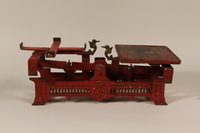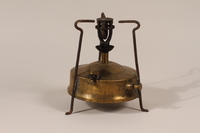Overview
- Brief Narrative
- G. Boulitte brand sphygmomanometer, or blood pressure monitor, and leather case of the type used in the Łódź Ghetto in German-occupied Poland from May 1940 to August 1944. Łódź was occupied by Germany a week after the September 1, 1939, invasion of Poland. The city was renamed Litzmannstadt, and in February 1940, approximately 160,000 people from the Jewish population were confined to a small, closed ghetto. All residents had to work, and many became forced laborers in ghetto factories. Eventually, nearly 100 factories were in operation. The major ones produced textiles, including uniforms for the Germany Army. Due to the severe overcrowding and scarce food, disease and starvation were common. Originally, the ghetto had seven hospitals, seven pharmacies, four clinics, and two emergency rooms where Jewish doctors and nurses attempted to help other residents with the limited resources available to them. The Judenrat (Jewish Council) were forced to administer the ghetto for the Germans. Judenrat chairman, Mordechai Rumkowski, thought hard work and high outputs would preserve the ghetto, but in January 1942, mass deportations to Chelmno killing center began. In September the entire hospital system was shut down, and all of the patients were deported. By the end of the year, half of the residents were murdered. In summer 1944, Łódź, the last ghetto in Poland, was destroyed, and the remaining Jews were sent to Chelmno and Auschwitz-Birkenau killing centers.
- Date
-
use:
approximately 1900-approximately 1945
- Geography
-
use:
Poland.
manufacture: Paris (France)
manufacture: Germany.
- Credit Line
- United States Holocaust Memorial Museum Collection
- Markings
- a. gauge, face, center, printed, black ink : ETABTS G. BOULITTE / CONSTRUCTEURS / PARIS / JÓZEF OLSZEWSKI / WARSZAWA [ETABTS G. Boulitte Manufacturers Paris Józef Olszewski Warsaw]
a. gauge, face, lower center, printed, black ink : CENTIMETRES / DE MERCURE [Centimeters of Mercury]
a. leather piece left of gauge, center, stamped : SPHYGMOPHONE / BOULITTE – KOROTKOW / BREVETÉ S.G.D.G [Sphygmophone Boulitte – Korotkow patented without government guarantee]
a. leather piece right of gauge, center, stamped : ETABTS G. BOULITTE / 15. RUE BOBILLOT / _PARIS_ [ETABTS G. Boulitte 15. Bobillot Street Paris]
d. clasp, base, center, engraved : BREV. SGDG. / FOREIGN PATS. [Patented without government guarantee Foreign Patents]
d. clasp, top piece, underside, center, engraved : TUCK-TITE / U.S.A. PAT. 15904 / GES GESCH / MADE IN GERMANY [Tuck-tite USA patent 15904 Protected by Law Made in Germany] - Contributor
-
Manufacturer:
G. Boulitte
Physical Details
- Classification
-
Tools and Equipment
- Category
-
Medical equipment
- Object Type
-
Sphygmomanometers (lcsh)
- Genre/Form
- Medical equipment & supplies.
- Physical Description
- a. Circular arm cuff for a sphygmomanometer or blood pressure meter made from a heavy, navy blue, twill cloth upper with a brown leather layer sewn to the underside. The cuff is sewn with thick thread, and several sections are attached or adjusted with silver-colored metal fittings and leather pieces sewn to the surface. A circular, metal gauge is attached to the front by two thin, leather straps with adjustable metal buckles. The glass-covered gauge has a white face with black ink graduation marks going clockwise from the bottom around the perimeter in increments of five from 1-30, and arranged around a thin, blue, pointed needle at center. French and Polish text is printed across the center and bottom. A short, leather hose extends from the bottom of the gauge to a metal fitting on a circular leather piece just above and left of the gauge. A longer hose is attached just below and right of the gauge. At the opposite end is a twisting circular air release valve and a ridged metal nozzle to attach a bulb (b.) A rectangular, leather label with rounded ends and stamped French text is sewn to the left and right of the gauge, and over the top ends of two cloth straps used to tighten the cuff on a patient’s arm. The straps are adjusted by metal slide clasps, which are secured by leather tabs. At the free end, each strap is sewn around a small, black plastic cylinder. The fabric is slightly pebbled, and the leather shows light deterioration overall.
b. Brown leather bulb with a wide center and narrow, cylindrical ends used as part of a sphygmomanometer. One end has a threaded silver-colored metal fitting on the inside, allowing it to screw onto the metal nozzle of a leather hose attached to the sphygmomanometer cuff (a.) At the other end is a metal end valve with a circular opening to release air. The bulb is cracking all around the center, with one particularly large crack going all the way through the leather.
c. Adjustable, navy blue, twill cloth strap with a circular stethoscope head attached in the center for use with a sphygmomanometer (a-b). The stethoscope is made of silver-colored metal with a black rubber border and speckled plastic over the face. A hollow post centered on the back of the stethoscope is screwed into the fabric and fastened by a metal washer and nut on the reverse. The strap is adjusted with a silver-colored metal slide clasp secured to the strap by a brown leather tab sewn around the bottom bar of the clasp. The bottom of the strap is sewn around a flattened, oval-shaped metal loop. The fabric is worn and fraying around the edges.
d. Rectangular, brown leather bag with stiff sides used to hold a sphygmomanometer (a-c). The bag has a fold-over top flap with a curved lower edge and is secured with a silver-colored metal, tuck lock clasp. The upper piece of the clasp is riveted onto the center of the flap edge, and has English and German text engraved across the underside. The base of the clasp is secured on the front, center of the bag, and has French and English text engraved across the center. On top of the flap, a short, perpendicular leather strap is riveted halfway between the center and each end in order to secure a flat, leather handle to the case. The ends of the handle are semicircular, and wider than the straps so they cannot pull free. The bag is sewn together at the seams with brown thread, and there is no interior lining. The bag is scratched throughout, with deterioration on the strap and around the edges of the flap. The rivets are heavily rusted, and there is teal corrosion around the clasp. - Dimensions
- a: Height: 5.125 inches (13.018 cm) | Width: 10.750 inches (27.305 cm) | Depth: 2.000 inches (5.08 cm)
b: Height: 4.250 inches (10.795 cm) | Width: 2.125 inches (5.398 cm) | Depth: 1.750 inches (4.445 cm)
c: Height: 9.750 inches (24.765 cm) | Width: 2.000 inches (5.08 cm) | Depth: 1.000 inches (2.54 cm)
d: Height: 7.000 inches (17.78 cm) | Width: 8.500 inches (21.59 cm) | Depth: 3.000 inches (7.62 cm) - Materials
- a : leather, cloth, metal, glass, ink, plastic, thread
b : leather, metal
c : cloth, leather, metal, rubber, plastic, thread
d : leather, metal, thread
Rights & Restrictions
- Conditions on Access
- No restrictions on access
- Conditions on Use
- No restrictions on use
Keywords & Subjects
- Topical Term
- Forced labor--Poland--Łódź. Health facilities. Holocaust, Jewish (1939-1945)--Poland. Jewish ghettos--Poland--Łódź. Jews--Persecutions--Poland. Medical care--Poland--Łódź. Slave labor--Poland--Łódź. World War, 1939-1945--Conscript labor--Poland--Łódź.
- Geographic Name
- Łódź (Poland) Paris (France) Germany.
- Corporate Name
- Litzmannstadt-Getto (Łódź, Poland)
Administrative Notes
- Legal Status
- Permanent Collection
- Provenance
- The sphygmomanometer was acquired by the United States Holocaust Memorial Museum in 1990.
- Record last modified:
- 2023-05-31 12:45:09
- This page:
- https://collections.ushmm.org/search/catalog/irn4108
Download & Licensing
In-Person Research
- By Appointment
- Request 21 Days in Advance of Visit
- Plan a Research Visit
- Request to See This Object
Contact Us
Also in Kielce, Poland collection
The collection consists of an alarm clock, a butcher scale, a primus alcohol stove, and a Sphygmomanometer relating to Kielce, Poland, before and during the Holocaust.
Date: approximately 1900-approximately 1945

Red metal butcher scale with marble weight
Object
Red, metal, measuring scale with a marble weight, of the type used in the Łódź Ghetto in German-occupied Poland from May 1940 to August 1944. Łódź was occupied by Germany a week after the September 1, 1939, invasion of Poland. The city was renamed Litzmannstadt, and in February 1940, approximately 160,000 people from the Jewish population were confined to a small, closed ghetto. All residents had to work, and many became forced laborers in ghetto factories. Eventually, nearly 100 factories were in operation. The major ones produced textiles, including uniforms for the Germany Army. Due to the severe overcrowding and scarcity of food, disease and starvation were common. The Judenrat (Jewish Council) were forced to administer the ghetto for the Germans. Judenrat chairman, Mordechai Rumkowski, thought hard work and high outputs would preserve the ghetto, but in January 1942, mass deportations to Chelmno killing center began. By the end of the year, half of the residents were murdered. In summer 1944, Łódź, the last ghetto in Poland, was destroyed, and the remaining Jews were sent to Chelmno and Auschwitz-Birkenau killing centers.

Primus brand, No. 1 model, alcohol stove
Object
Primus brand alcohol stove of the type used in the Łódź Ghetto in German-occupied Poland from May 1940 to August 1944. Łódź was occupied by Germany a week after the September 1, 1939, invasion of Poland. The city was renamed Litzmannstadt, and in February 1940, approximately 160,000 people from the Jewish population were confined to a small, closed ghetto. All residents had to work, and many became forced laborers in ghetto factories. Eventually, nearly 100 factories were in operation. The major ones produced textiles, including uniforms for the Germany Army. In the ghetto, people attempted to maintain their normal lives, despite the increasing hardships. Women, when they were not laboring in the factories, worked to prepare food and do laundry for their families. These activities were made difficult by the meager food rations they received, and the lack of running water throughout most of the ghetto. Due to the severe overcrowding and scarce food, disease and starvation were common. The Judenrat (Jewish Council) were forced to administer the ghetto for the Germans. Judenrat chairman, Mordechai Rumkowski, thought hard work and high outputs would preserve the ghetto, but in January 1942, mass deportations to Chelmno killing center began. By the end of the year, half of the residents were murdered. In summer 1944, Łódź, the last ghetto in Poland, was destroyed, and the remaining Jews were sent to Chelmno and Auschwitz-Birkenau killing centers.
Junghans single-bell alarm clock
Object
Junghans brand alarm clock of the type used in the Łódź Ghetto in German-occupied Poland from May 1940 to August 1944. This alarm clock was manufactured in Silberberg, Germany, which became Srebrna Góra, Poland after World War II. Łódź was occupied by Germany a week after the September 1, 1939, invasion of Poland. The city was renamed Litzmannstadt, and in February 1940, approximately 160,000 people from the Jewish population were confined to a small, closed ghetto. All residents had to work, and many became forced laborers in ghetto factories. Eventually, nearly 100 factories were in operation. The major ones produced textiles, including uniforms for the Germany Army. Due to the severe overcrowding and scarce food, disease and starvation were common. The Judenrat (Jewish Council) were forced to administer the ghetto for the Germans. Judenrat chairman, Mordechai Rumkowski, thought hard work and high outputs would preserve the ghetto, but in January 1942, mass deportations to Chelmno killing center began. By the end of the year, half of the residents were murdered. In summer 1944, Łódź, the last ghetto in Poland, was destroyed, and the remaining Jews were sent to Chelmno and Auschwitz-Birkenau killing centers.



